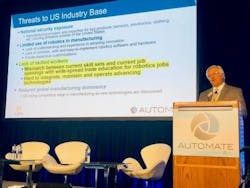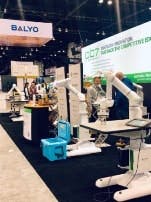Automate 2019: Robots to the rescue?
There were drones. There were exoskeletons. There were lots, and lots, of robots—boxing robots, bowling robots, musical-instrument-playing robots, and robots actually engaged in useful industrial applications.
The biennial (and co-located) Automate and ProMat shows returned to Chicago's McCormick Place this week, and for all of the bells and whistles on display on the exhibition floors, the emphasis was on enabling and expanding automation's presence on the plant floor not to realize some shiny, robot-driven vision of the production floor or warehouse of the future but to help address real-life labor shortages that manufacturers are contending with right now.The Automate Show and Conference is moving to Detroit. Read the announcement: Automate Moves to Motown in 2021
Chris Merta, a product manager at The Raymond Corp., which sells autonomous guided vehicles (AGVs) and automated storage and retrieval tools as well as traditional warehouse lift trucks, said he has seen a new urgency in the past year not from the C-suite but from manufacturers' plant-floor employees to implement more automated technologies. One supervisor he worked with recently, Merta relayed, shared a not-uncommon frustration: "I've got 70 jobs to be done and 50 people to do them – what can I automate?"
For those who might view with alarm a manufacturer's interest in finding new ways to have automated tools take on tasks that have been performed by humans, Stephen Catt, deputy director for education and workforce development at the not-for-profit Advanced Robotics for Manufacturing (ARM) institute in Pittsburgh, has a response.
"I've had the opportunity in the past two years to visit a lot of companies," Catt said during his "Workforce Urgency" presentation at Automate on Thursday. "Every manager that puts in a new robot wants to show me their new robot. And every one of them, I ask the same question: How many people did you lay off or fire when you put this robot in? They look at me like I have two heads. 'We didn't fire or lay off anybody,' they say. … (They explain) 'There are 1,000 other jobs I need them to do, and they know my culture; they are my experts … why would I get rid of any of them?' "Even exhibitors themselves are hurting for talent, said Bob Doyle, VP of the Robotic Industries Association (RIA) and A3 Mexico. (The Association for Advancing Automation, or A3, produces the Automate conference.) "Many of our exhibitors are struggling finding people," Doyle said. "There's a huge opportunity … In general, I feel like we've lost a generation of workers in manufacturing because our grandparents told us not to work in the factory that they worked in."
Amid that labor crunch, advanced robotics and other automation-driven technologies can help manufacturers address workforce needs in two critical ways, Catt and others at the Automate and ProMat shows indicated. The first is by taking on some of the highly repetitive, low-skill, and/or high-risk tasks that manufacturers are increasingly having a hard time getting people to sign on for; the second is by helping young people get excited about the more-connected, data-rich direction in which U.S. manufacturing is headed – and the creative, higher-skill roles that will help power the industry, and by extension U.S. economic competitiveness, forward.
"We need a workforce that is continuously learning all of the time," Catt said. "The United States is a little bit behind at this point; we want to make up for it and stream ahead."


